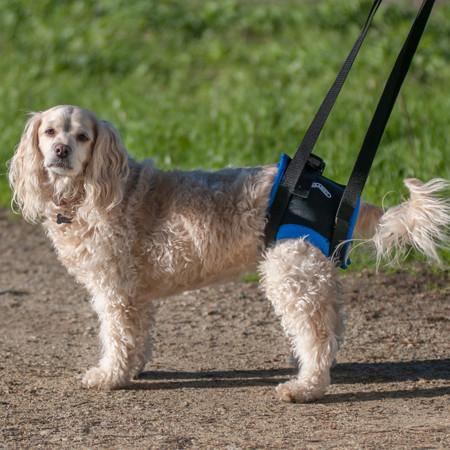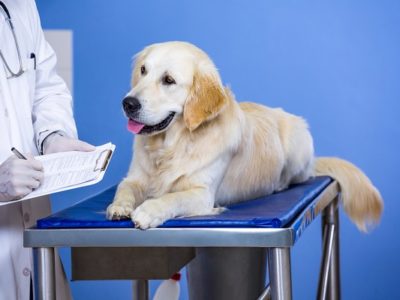There’s no truer saying than, “life can turn on a dime” when you’re talking about strokes in dogs. They happen suddenly and change a dog and their family’s life forever. This fact hit home for a pet mom named Risa and her sweet dog, Mia on June 6, 2015.
Table of Contents[Hide][Show]

Risa arrived home from work and let her dogs out in the yard, like she did every afternoon. Mia, a one-year-old dog who had recently joined the family, ran outside with her housemates and dashed back to Risa. Then she abruptly collapsed at her feet.
The dog had a seizure and then her body went limp. She couldn’t move and had a hard time breathing. Risa rushed Mia to their vet. Unable to stabilize the dog, Mia was transferred to a specialist who diagnosed her with a Fibrocartilaginous Embolism (FCE stroke).
Mia’s recovery was slow, but it has a happy ending. She was treated with hyperbaric oxygen therapy which places a dog into a chamber that delivers 100% oxygen. Today, Mia’s back playing with her housemates.
FCE is one of two primary causes of strokes in dogs. Our pups are also susceptible to vascular accidents. This is the kind of stroke we see in humans.
Both vascular and FCE strokes are considered to be medical emergencies that should be treated immediately. For this reason, it’s important for pet owners to be aware of the symptoms and understand the treatment.

Ask & Discover
Get personalized content recommendations and answers drawn from our website. Simply type your question or topic of interest, and our AI assistant will help you find relevant articles, tips, and insights. You can also have a natural conversation to explore topics in more depth.
Understanding a vascular accident

There are two main causes of a vascular accident. An ischemic stroke starts when there’s a blockage that obstructs blood flow to the brain. A hemorrhagic stroke occurs when a blood vessel ruptures.
Each form prevents blood and oxygen from getting to the brain.
Without oxygen the neurons, which are responsible for sending electrical signals and instructions to the brain, die off. This in turn causes the effected portion of the brain to stop working.
Vascular accidents happen for a variety of reasons:
“Underlying disease can be found in approximately 50 percent of dogs with vascular accidents.”
Dr. Wendy Brooks, Veterinary Partner
Symptoms of a stroke
Vascular accidents can have a variety of symptoms. Each is based on the part of the brain that was injured during the stroke. The symptoms are based on: the Cerebral cortex, Midbrain and Brainstem.
Cerebral cortex (front of the brain)
Midbrain symptoms

Get the Essential Guide
The Essential Guide of Products for Handicapped Dogs e-book is a labor of love for me. I wrote it to answer your most pressing questions about where to find the best products for your wheelchair dog. You’ll find products you didn’t know existed and each will improve your dog’s quality of life. Print a copy and keep it by your side.
Brainstem signs of a stroke
Treatment for vascular strokes in dogs

The primary treatment for a vascular stroke is called “supportive care.” That consists of getting oxygen to the brain so it has time to heal, keeping pressure off the brain and treating any seizures.
Many dogs need to be hospitalized during this time and on occasion, a feeding tube or ventilator is used.
The majority of patients make a full or partial recovery and when they’re feeling better, physical therapy is often prescribed. This treatment helps them regain function in the limbs affected by the stroke.
Two interesting facts:
A few dog breeds seem to have a higher occurrence of vascular accidents. They are: Greyhounds, Miniature Schnauzers, and Cavalier King Charles Spaniels.
A clinical study found the best predictor of how well a dog recovered after a stroke depended on underlying medical conditions. Dogs with chronic health problems, had the shortest survival rate.
Fibrocartilaginous Embolism (FCE) spinal strokes

FCE spinal strokes happen to healthy, young dogs who are typically between 3-6 years-old. Most of the time, a dog is running or playing when the stroke occurs.
The theory is the physical activity somehow forces a small piece of cartilage in the spine to break off. The fragment travels through the bloodstream until it gets lodged. This creates a blockage or embolism, in the arteries of the spinal cord.
The lack of blood flow causes instant paralysis to the limbs and routinely affects other parts of the body, like the lungs.
FCE strokes are severe and have an abrupt onset. One minute a dog is running around normally and the next minute they’re on the ground fighting for their life.

My favorite harnesses for disabled dogs.
Symptoms of a FCE stroke in dogs:
Here’s a tip: FCE strokes can mimic the symptoms of a ruptured disc. One way to differentiate the two is that victims of a stroke Do Not have pain or tenderness in their spine when you touch it.
Treatment for FCE strokes
Immediate intervention is necessary for FCE stroke victims, so contact your veterinarian as soon as possible. Some dogs need to be hospitalized if their symptoms are life-threatening.
With treatment the majority of patients feel better quickly and return home after 24 hours. Then, depending on the severity of the paralysis or weakness, dogs are sent for rehab. Patients respond well to physical therapy, hydrotherapy, acupuncture and hyperbaric oxygen therapy.
FCE survivors have a good recovery rate. More than 70 percent of dogs have improved symptoms 3 weeks after the incident.












Leave a Reply